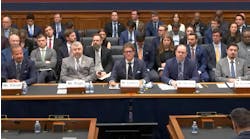Vehicle-to-vehicle, or V2V, technology — one of the promising new possibilities taking shape as part of "smart cities" or "smart infrastructure" — took a step today toward becoming not an if but a when. The National Highway Traffic Safety Administration (NHTSA) released a proposed rule this morning looking to require and standardize V2V communications for new light vehicles.
The agency says it sees great promise in V2V technology, but believes that unless there's a single format and programming environment established and mandated now for vehicles to "talk" to each other, the technology will be developed piecemeal from various, proprietary directions. If that's allowed to happen, V2V tech essentially could end up a tangled mess or fail to catch on, and a beneficial V2V-enabled roadway future may never emerge.
"Without a mandate to require and standardize V2V communications, the agency believes that manufacturers will not be able to move forward in an efficient way and that a critical mass of equipped vehicles would take many years to develop, if ever," NHTSA states in the proposed rule.
On the other hand, if an orderly groundwork can be set for V2V communications, NHTSA hopes the technology might someday "prevent hundreds of thousands of crashes and prevent over 1,000 fatalities annually."
The proposed rule maps out a plan for light vehicles to be able to send and receive "basic safety messages" about things like their speed, location and bearing. The idea is that the shared info potentially could then drive other technology like automatic braking and other autonomous "course-correcting" action to prevent collisions and subsequent injuries and deaths.
Regarding when this V2V communication would be required, "assuming a final rule is issued in 2019, this would mean that the phase-in period would begin in 2021, and all vehicles subject to that final rule would be required to comply in 2023," NHTSA states.
The lengthy, 675-page proposed rule is scheduled to be published in the Federal Register on Thursday, Jan. 12, and comments will be accepted for 90 days afterward. Comments can be submitted at https://www.regulations.gov/docket?D=NHTSA-2016-0126.



